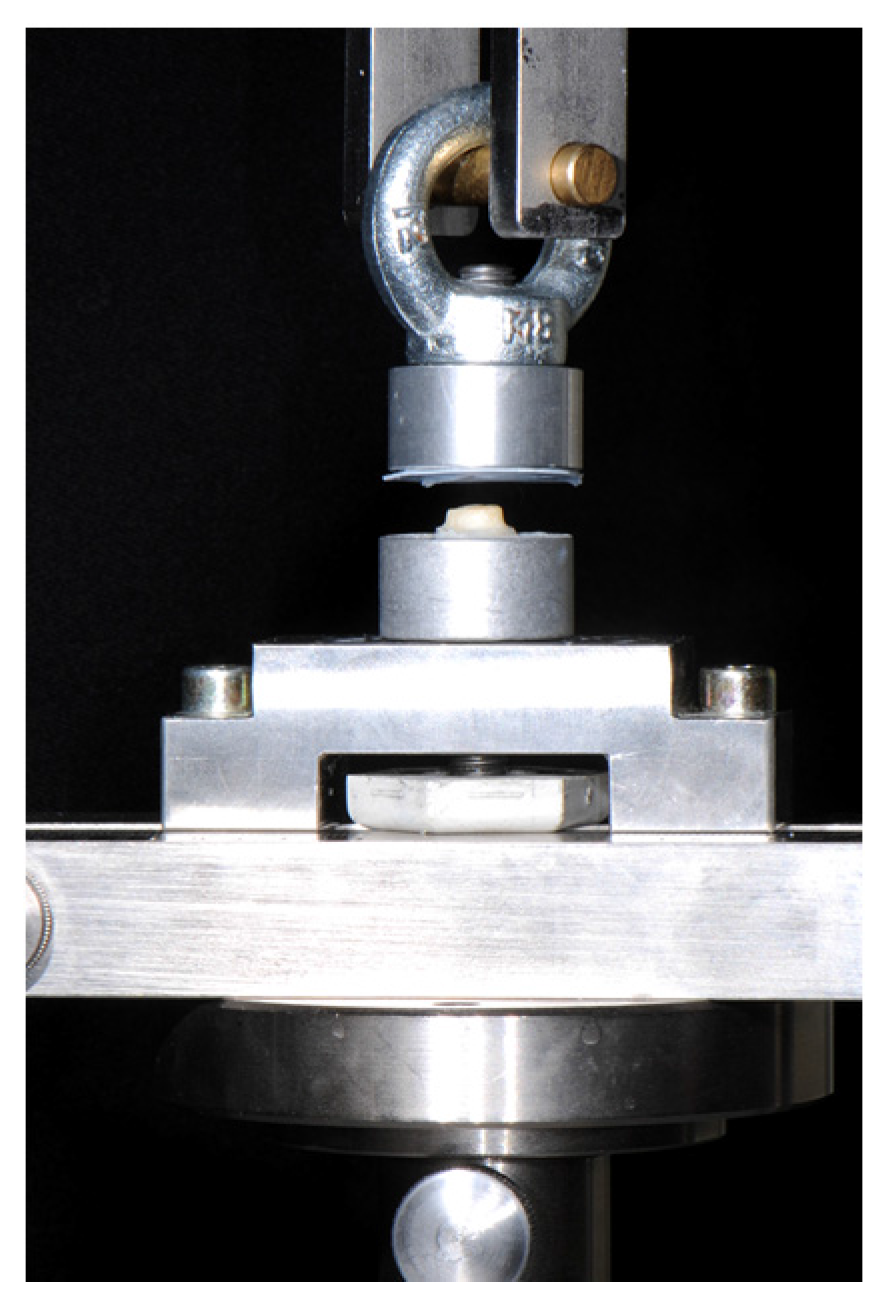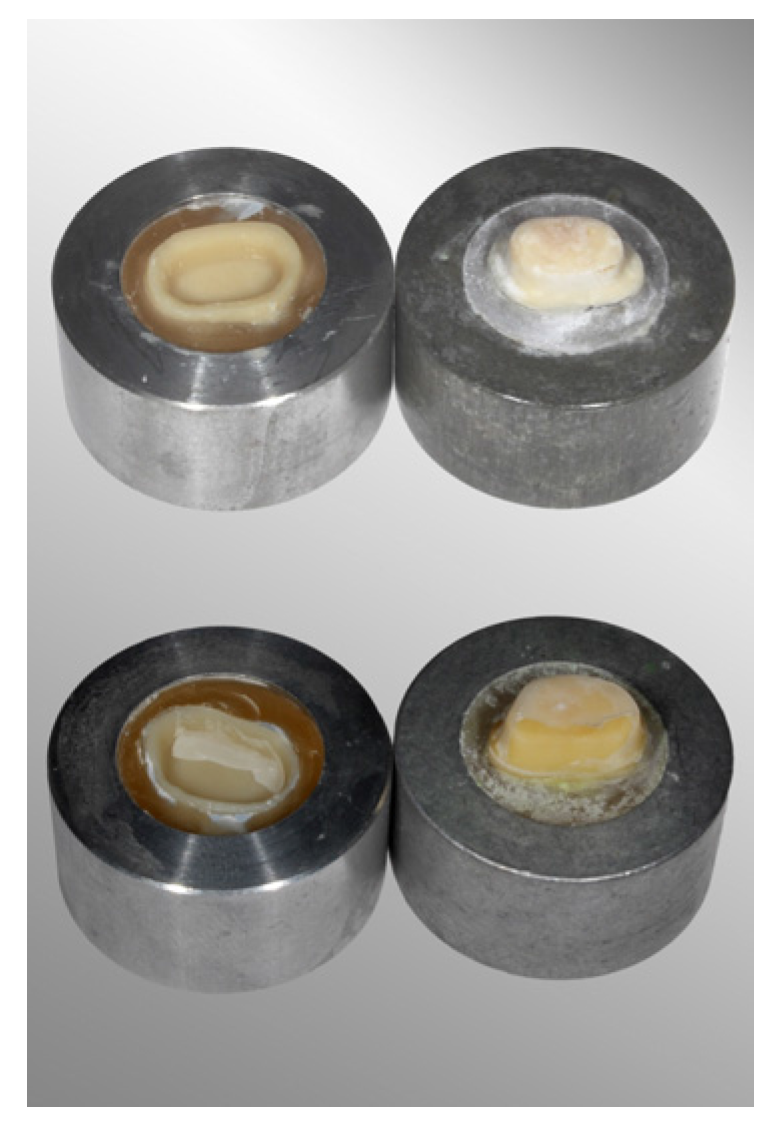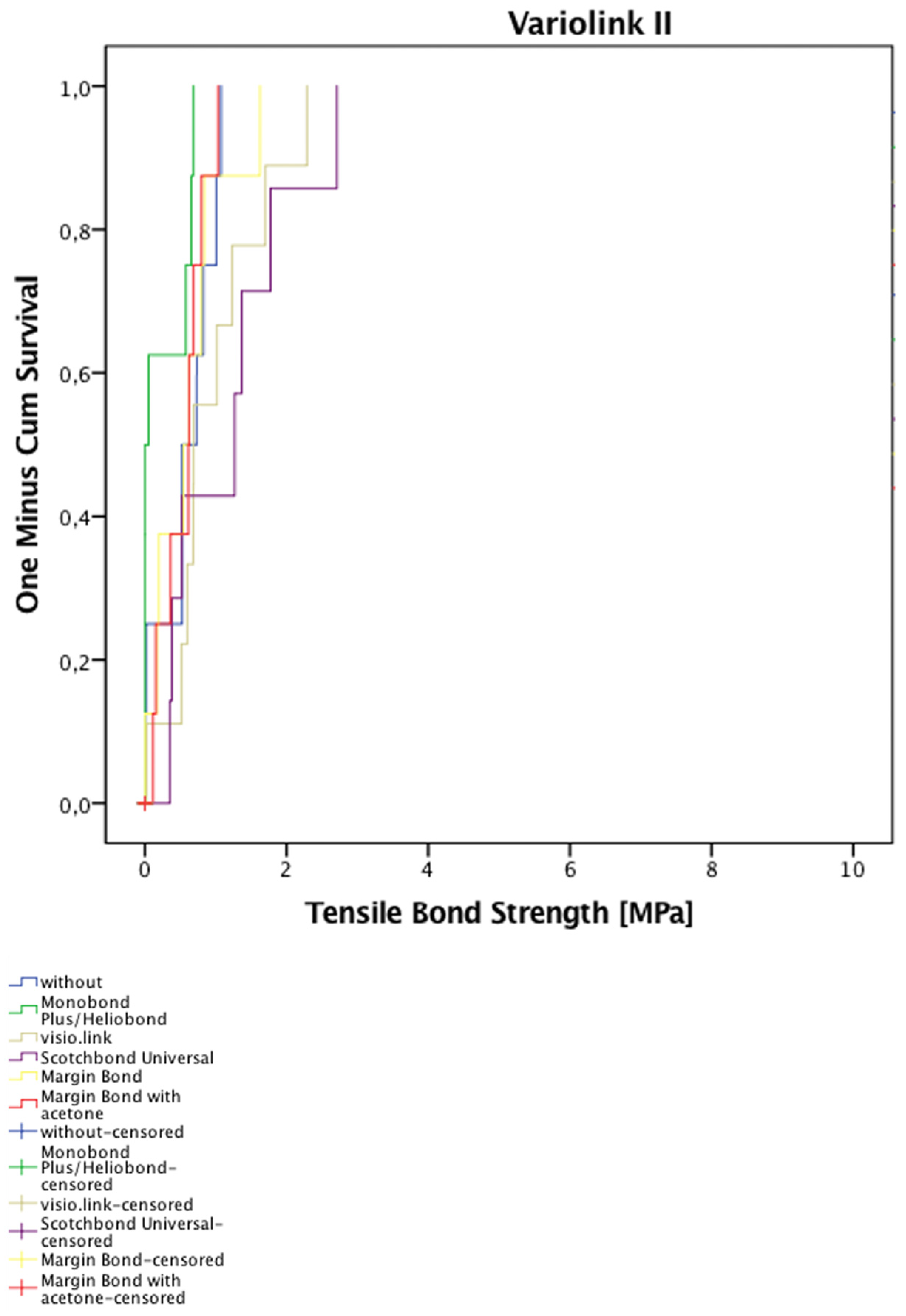Retention Strength of PMMA/UDMA-Based Crowns Bonded to Dentin: Impact of Different Coupling Agents for Pretreatment
Abstract
:1. Introduction
2. Material and Methods
| Materials | Manufacturer | Lot No. | Compositions | |
|---|---|---|---|---|
| CAD/CAM-blank | XHIPC-CAD/CAM-blank | Xplus3, Echzell, Germany | 425120 | 50%–80%: PMMA |
| 10%–20%: UDMA, BDDMA, mutli-methacrylate | ||||
| app. 15% filler | ||||
| Pretreatment of dental hard tissue | Total etch | Ivoclar Vivadent, Schaan, Liechtenstein | R29459 | 37% phosphoric acid |
| Syntac Classic | Ivoclar Vivadent, Schaan, Liechtenstein | R46617 | Primer: TEGDMA; polyethylene glycol dimethacrylate; maleic acid; acetone in aqueous solution | |
| Adhesive: polyethylene glycol dimethacrylate; glutaraldehyde in aqueous solution | ||||
| Heliobond: Bis-GMA; TEGDMA; stabilizers; catalysts | ||||
| Scotchbond Universal * | 3M ESPE, Seefeld, Germany | 520594 | Bis-GMA; HEMA; decamethylene dimethacrylate; silane treated silica; ethanol; water; 2-propenoic acid, 2-methyl-, reaction products with 1,10-decanediol and phosphorous oxide (P2O5); copolymer of acrylic and itaconic acid; dimethylaminobenzoat(-4); (dimethylamino)ethyl methacrylate; camphorquinone; methyl ethyl ketone | |
| Coupling agent for pretreatment of CAD/CAM crown | visio.link | bredent, Senden, Germany | 114784 | methyl methacrylate; 2-propenoic acid reaction products with pentaerythritol; diphenyl(2,4,6,-trimethylbenzoyl)-phosphineoxide |
| Scotchbond Universal * | 3M ESPE, Seefeld, Germany | 520594 | Bis-GMA; HEMA; decamethylene dimethacrylate; silane treated silica; ethanol; water; 2-propenoic acid, 2-methyl-, reaction products with 1,10-decanediol and phosphorous oxide (P2O5); copolymer of acrylic and itaconic acid; dimethylaminobenzoat(-4); (dimethylamino)ethyl methacrylate; camphorquinone; methyl ethyl ketone | |
| Monobond Plus/Heliobond * | Ivoclar Vivadent, Schaan, Liechtenstein | Monobond Plus: R26662; | Monobond Plus: silane methacrylate; phosphoric acid methacrylate; sulphide methacrylate in alcohol solution | |
| Heliobond: P00865 | Heliobond: Bis-GMA; TEGDMA; stabilizers; catalysts | |||
| Margin Bond | Coltène Whaledent, Altstätten, Switzerland | F22965 | Bis-GMA; TEGDMA | |
| Margin Bond 50% | Coltène Whaledent, Altstätten, Switzerland | CK131002 | Bis-GMA; TEGDMA; acetone | |
| Resin composite cements | Variolink II | Ivoclar Vivadent, Schaan, Liechtenstein | Base: R46653; | Bis-GMA; TEGDMA, UDMA; barium glass; ytterbium trifluoride; Ba-Al-fluorosilicate glass; spheroid mixed oxide, catalyst, stabilizers, pigments |
| Catalyst: LOT P84939 | ||||
| RelyX Ultimate | 3M ESPE, Seefeld, Germany | 509010 | glass powder, surface modified with 2-propenoic acid, 2 methyl-3-(trimethoxysilyl)propyl ester and phenyltrimethoxy silane; bulk material; 2-propenoic acid; 2-methyl-, 1,1′-[1-(hydroxymethyl)-1,2-ethanediyl] ester; reaction products with 2-hydroxy-1,3-propanediyl dimethacrylate and phosphorus oxide; TEGDMA; silane treated silica; oxide glass chemicals (non-fibrous); sodium persulfate; TBPIN |
2.1. Specimen Preparation
- (A)
- Visio.link (bredent) was applied on the crown surface and polymerized for 90 s.
- (B)
- Scotchbond Universal (3M ESPE) was applied on the crown surface and polymerized for 10 s.
- (C)
- Monobond Plus/Heliobond (Ivoclar Vivadent). Monobond Plus was applied on the crown surface and air-dried for 60 s; Heliobond was applied and polymerized for 10 s.
- (D)
- Margin Bond (Coltène Whaledent) was applied on the crown surface and polymerized for 10 s.
- (E)
- Margin Bond mixed with acetone (1:1) (Coltène Whaledent) was applied on the crown surface and polymerized for 10 s.
- (F)
- No treatment (control group).
- (I)
- Variolink II (Ivoclar Vivadent): the tooth surface was etched (37% phosphoric acid; Total etch) and pretreated according to the manufacturer’s recommendations using the Syntac Classic assortment.
- (II)
- RelyX Ultimate (3M ESPE): the tooth surface was etched (37% phosphoric acid; Total etch) and pretreated according to the manufacturer’s recommendations using Scotchbond Universal.
- (i)
- resin composite cement remains on dentine
- (ii)
- resin composite cement remains on polymeric CAD/CAM crown
- (iii)
- mixed failure of types (i) and (ii)

2.2. Statistics
3. Results
| Coupling Agents | RelyX Ultimate | Variolink II | ||
|---|---|---|---|---|
| mean ± SD | 95% CI | mean ± SD | 95% CI | |
| visio.link | 2.08 ± 1.33 a | 1.12; 3.03 | 0.87 ± 0.71 a | 0.36; 1.39 |
| Scotchbond Universal | 2.13 ± 1.56 a | 0.99; 3.25 | 0.84 ± 0.91 a | 0.18; 1.49 |
| Monobond Plus/Heliobond | 2.50 ± 1.71 a | 1.28; 3.73 | 0.20 ± 0.03 a | −0.02; 0.42 |
| Margin Bond | 2.00 ± 1.26 a | 1.09; 2.89 | 0.48 ± 0.52 a | 0.10; 0.85 |
| Margin Bond with acetone (1:1) | 3.23 ± 2.70 a | 1.29; 5.17 | 0.44 ± 0.36 a | 0.17; 0.70 |
| without | 4.49 ± 2.11 a | 2.98; 6.01 | 0.47 ± 0.44 a | −0.14; 0.78 |
| Source of Variability | Sum of Squares | df | Mean Squares | F | p-Value |
|---|---|---|---|---|---|
| Constant parameters | 324.5 | 1 | 324.5 | 172.7 | <0.001 |
| Resin composite cement | 143.8 | 1 | 143.8 | 76.5 | <0.001 |
| Coupling agents | 20.9 | 5 | 4.2 | 2.2 | 0.057 |
| Resin composite cement vs. * coupling agents | 29.9 | 5 | 6.0 | 3.2 | 0.010 |
| Error | 202.9 | 108 | 1.9 | – | – |
| Total | 721.9 | 120 | – | – | – |



| Coupling Agents | RelyX Ultimate Median (95% CI) (MPa) | Variolink II Median (95% CI) (MPa) |
|---|---|---|
| visio.link | 1.9 (1.21; 2.61) | 0.69 (0.66; 0.70) |
| Scotchbond Universal | 1.32 (0.78; 1.86) | 1.27 (0.0; 3.18) |
| Monobond Plus/Heliobond | 2.35 (1.85; 2.85) | 0.004 (0.0; 0.08) |
| Margin Bond | 1.38 (0.59; 2.15) | 0.54 (0.0; 1.14) |
| Margin Bond with acetone (1:1) | 1.35 (1.25; 1.45) | 0.62 (0.25; 0.98) |
| without | 3.96 (1.38; 6.55) | 0.52 (0.22; 0.82) |
4. Discussion
5. Conclusions
- The tested universal coupling agents showed no impact on the retention strength results.
- Pretreatment with Margin Bond compared to Margin Bond mixed with acetone showed no impact on the retention strength results.
- Crowns cemented using RelyX Ultimate showed higher retention strength than those polymerized with Variolink II.
- Mixed failure types were found most frequently in groups bonded using RelyX Ultimate. In contrast, composite resin cement remaining on dentin within crowns bonded using Variolink II.
- Within Variolink II groups, crowns pretreated with Monobond Plus/Heliobond showed a lower estimated cumulative function of the debonded crown than the remaining pretreatment groups.
Acknowledgments
Author Contributions
Conflicts of Interest
References
- Perry, R.D.; Magnuson, B. Provisional materials: Key components of interim fixed restorations. Compend. Contin. Educ. Dent. 2012, 33, 59–60. [Google Scholar] [PubMed]
- Driscoll, C.F.; Woolsey, G.; Ferguson, W.M. Comparison of exothermic release during polymerization of four materials used to fabricate interim restorations. J. Prosthet. Dent. 1991, 65, 504–506. [Google Scholar] [CrossRef]
- Young, H.M.; Smith, C.T.; Morton, D. Comparative in vitro evaluation of two provisional restorative materials. J. Prosthet. Dent. 2001, 85, 129–132. [Google Scholar] [CrossRef] [PubMed]
- Edelhoff, D.; Beuer, F.; Schweiger, J.; Brix, O.; Stimmelmayr, M.; Güth, J.F. CAD/CAM-generated high-density polymer restorations for the pretreatment of complex cases: A case report. Quintessence Int. 2012, 43, 457–467. [Google Scholar] [PubMed]
- Güth, J.F.; Almeida, E.S.J.S.; Beuer, F.F.; Edelhoff, D. Enhancing the predictability of complex rehabilitation with a removable CAD/CAM-fabricated long-term provisional prosthesis: A clinical report. J. Prosthet. Dent. 2012, 107, 1–6. [Google Scholar] [CrossRef]
- Güth, J.F.; Almeida, E.S.J.S.; Ramberger, M.; Beuer, F.; Edelhoff, D. Treatment concept with CAD/CAM-fabricated high-density polymer temporary restorations. J. Esthet. Restor. Dent. 2012, 24, 310–318. [Google Scholar] [CrossRef] [PubMed]
- Alt, V.; Hannig, M.; Wöstmann, B.; Balkenhol, M. Fracture strength of temporary fixed partial dentures: CAD/CAM versus directly fabricated restorations. Dent. Mater. 2011, 27, 339–347. [Google Scholar] [CrossRef] [PubMed]
- Basaran, E.G.; Ayna, E.; Vallittu, P.K.; Lassila, L.V. Load bearing capacity of fiber-reinforced and unreinforced composite resin CAD/CAM-fabricated fixed dental prostheses. J. Prosthet. Dent. 2013, 109, 88–94. [Google Scholar] [CrossRef]
- Stawarczyk, B.; Ender, A.; Trottmann, A.; Özcan, M.; Fischer, J.; Hämmerle, C.H. Load-bearing capacity of CAD/CAM milled polymeric three-unit fixed dental prostheses: Effect of aging regimens. Clin. Oral Investig. 2012, 16, 1669–1677. [Google Scholar] [CrossRef] [PubMed]
- Wimmer, T.; Ender, A.; Roos, M.; Stawarczyk, B. Fracture load of milled polymeric fixed dental prostheses as a function of connector cross-sectional areas. J. Prosthet. Dent. 2013, 110, 288–295. [Google Scholar] [CrossRef]
- Attia, A.; Abdelaziz, K.M.; Freitag, S.; Kern, M. Fracture load of composite resin and feldspathic all-ceramic CAD/CAM crowns. J. Prosthet. Dent. 2006, 95, 117–123. [Google Scholar] [CrossRef] [PubMed]
- Stawarczyk, B.; Özcan, M.; Trottmann, A.; Schmutz, F.; Roos, M.; Hämmerle, C. Two-body wear rate of CAD/CAM resin blocks and their enamel antagonists. J. Prosthet. Dent. 2013, 109, 325–332. [Google Scholar] [CrossRef]
- Stawarczyk, B.; Sener, B.; Trottmann, A.; Roos, M.; Özcan, M.; Hämmerle, C.H. Discoloration of manually fabricated resins and industrially fabricated CAD/CAM blocks versus glass-ceramic: Effect of storage media, duration, and subsequent polishing. Dent. Mater. J. 2012, 31, 377–383. [Google Scholar] [CrossRef] [PubMed]
- Keul, C.; Martin, A.; Wimmer, T.; Roos, M.; Gernet, W.; Stawarczyk, B. Tensile bond strength of PMMA- and composite-based CAD/CAM materials to luting cements after different conditioning methods. Int. J. Adhes. Adhes. 2013, 46, 122–127. [Google Scholar] [CrossRef]
- Bähr, N.; Keul, C.; Edelhoff, D.; Eichberger, M.; Roos, M.; Gernet, W.; Stawarczyk, B. Effect of different adhesives combined with two resin composite cements on shear bond strength to polymeric CAD/CAM materials. Dent. Mater. J. 2013, 32, 492–501. [Google Scholar] [CrossRef] [PubMed]
- Stawarczyk, B.; Basler, T.; Ender, A.; Roos, M.; Özcan, M.; Hämmerle, C. Effect of surface conditioning with airborne-particle abrasion on the tensile strength of polymeric CAD/CAM crowns luted with self-adhesive and conventional resin cements. J. Prosthet. Dent. 2012, 107, 94–101. [Google Scholar] [CrossRef]
- Da Costa, T.R.F.; Serrano, A.M.; Atman, A.P.F.; Loguercio, A.D.; Reis, A. Durability of composite repair using different surface treatments. J. Dent. 2012, 40, 513–521. [Google Scholar] [CrossRef] [PubMed]
- D’Arcangelo, C.; Vanini, L. Effect of three surface treatments on the adhesive properties of indirect composite restorations. J. Adhes. Dent. 2007, 9, 319–326. [Google Scholar] [PubMed]
- Keul, C.; Kohen, D.; Eichberger, M.; Roos, M.; Gernet, W.; Stawarczyk, B. The effect of different pretreatment methods of PMMA-based crowns on the long-term tensile bond strength to dentin abutments. Clin. Oral Investig. 2015, 19, 35–43. [Google Scholar] [CrossRef] [PubMed]
- Stawarczyk, B.; Stich, N.; Eichberger, M.; Edelhoff, D.; Roos, M.; Gernet, W.; Keul, C. Long-term tensile bond strength of differently cemented nanocomposite CAD/CAM crowns on dentin abutment. Dent. Mater. 2014, 30, 334–342. [Google Scholar] [CrossRef] [PubMed]
- Lührs, A.K.; Pongprueksa, P.; de Munck, J.; Geurtsen, W.; van Meerbeek, B. Curing mode affects bond strength of adhesively luted composite CAD/CAM restorations to dentin. Dent. Mater. 2014, 30, 281–291. [Google Scholar] [CrossRef] [PubMed]
- Ferracane, J.L. Resin composite—State of the art. Dent. Mater. 2011, 27, 29–38. [Google Scholar] [CrossRef] [PubMed]
- Ruse, N.D.; Sadoun, M.J. Resin-composite blocks for dental CAD/CAM applications. J. Dent. Res. 2014, 93, 1232–1234. [Google Scholar] [CrossRef] [PubMed]
- Ernst, C.P.; Wenzl, N.; Stender, E.; Willershausen, B. Retentive strengths of cast gold crowns using glass ionomer, compomer, or resin cement. J. Prosthet. Dent. 1998, 79, 472–476. [Google Scholar] [CrossRef]
- Palacios, R.P.; Johnson, G.H.; Phillips, K.M.; Raigrodski, A.J. Retention of zirconium oxide ceramic crowns with three types of cement. J. Prosthet. Dent. 2006, 96, 104–114. [Google Scholar] [CrossRef] [PubMed]
- Stawarczyk, B.; Hartmann, L.; Hartmann, R.; Roos, M.; Ender, A.; Özcan, M.; Hämmerle, C.H. Impact of Gluma Desensitizer on the tensile strength of zirconia crowns bonded to dentin: An in vitro study. Clin. Oral Investig. 2012, 16, 201–213. [Google Scholar] [CrossRef] [PubMed]
- Uhrenbacher, J.; Schmidlin, P.R.; Keul, C.; Eichberger, M.; Roos, M.; Gernet, W.; Stawarczyk, B. The effect of surface modification on the retention strength of polyetheretherketone crowns adhesively bonded to dentin abutments. J. Prosthet. Dent. 2014, 112, 1489–1497. [Google Scholar] [CrossRef] [PubMed]
- ISO/TS 11405:2003. Dental materials—Testing of Adhesion to Tooth Structure; Multiple. Distributed through American National Standards Institute (ANSI): Washington, DC, USA, 2008.
© 2015 by the authors; licensee MDPI, Basel, Switzerland. This article is an open access article distributed under the terms and conditions of the Creative Commons by Attribution (CC-BY) license (http://creativecommons.org/licenses/by/4.0/).
Share and Cite
Stawarczyk, B.; Teuss, S.; Eichberger, M.; Roos, M.; Keul, C. Retention Strength of PMMA/UDMA-Based Crowns Bonded to Dentin: Impact of Different Coupling Agents for Pretreatment. Materials 2015, 8, 7486-7497. https://doi.org/10.3390/ma8115396
Stawarczyk B, Teuss S, Eichberger M, Roos M, Keul C. Retention Strength of PMMA/UDMA-Based Crowns Bonded to Dentin: Impact of Different Coupling Agents for Pretreatment. Materials. 2015; 8(11):7486-7497. https://doi.org/10.3390/ma8115396
Chicago/Turabian StyleStawarczyk, Bogna, Simona Teuss, Marlis Eichberger, Malgorzata Roos, and Christine Keul. 2015. "Retention Strength of PMMA/UDMA-Based Crowns Bonded to Dentin: Impact of Different Coupling Agents for Pretreatment" Materials 8, no. 11: 7486-7497. https://doi.org/10.3390/ma8115396
APA StyleStawarczyk, B., Teuss, S., Eichberger, M., Roos, M., & Keul, C. (2015). Retention Strength of PMMA/UDMA-Based Crowns Bonded to Dentin: Impact of Different Coupling Agents for Pretreatment. Materials, 8(11), 7486-7497. https://doi.org/10.3390/ma8115396







